Barcelona’s High-Pressing Strategy vs Napoli
During Barcelona’s Champions League last-16 first-leg tie vs Napoli, their high-pressing strategy yielded mixed results.
There were 3 key ways in which they attempted to create regain opportunities: 1. Forcing long, central kicks from Ospina in order to win the ball aerially with Pique or Umtiti; 2. Trapping Napoli into clipping to their full-backs, especially the left-back. Barcelona’s wingers would then press aggressively backwards joined by a CM and/or FB. 3. Trap Napoli into playing back to their GK and then out to the opposite FB in order to regain this misplaced pass.
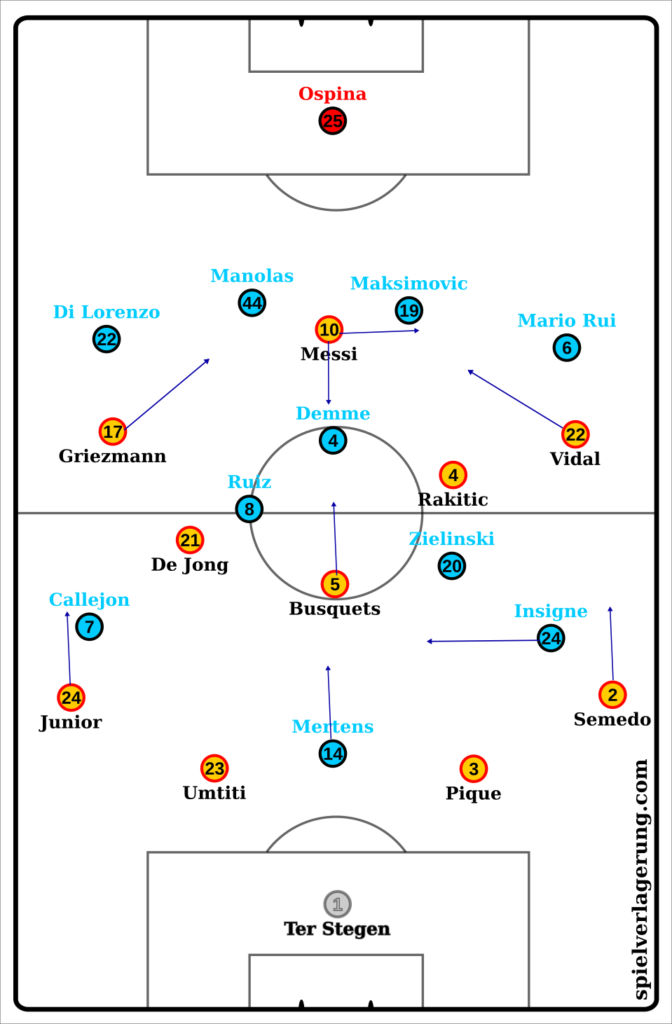
Barclona played a 4-3-3, with Vidal and Griezmann coming inside to allow for Junior and Semedo to move forward and wide. Messi would also drift deep and to the right.
In order to create these 3 situations, Barcelona pressed with some consistent principles and methods. They regularly placed aggressive pressure on Ospina in order to rush the goalkeeper and force long-kicks. This tended to be from one of the three midfielders, but occasionally saw one of the front three apply pressure. The aerial superiority of Pique and Umtiti against Mertens and occassionally Insigne resulted in this leading to a regain opportunity.
Their three centre-midfielders, Busquets (no.6), Rakitics (no.8) and De Jong (no.8) pressed in a very man-orientated way on the three Napoli centre-midfielders. This meant they were more concerned with following a midfielder, rather than defending spaces. This was a ploy to encourage Napoli to kick long, or clip into FB areas, which triggered a pressing trap.
A third element was aggressive pressing on the touchline in order to force fouls or throw-ins. In general, Barcelona pressed over-aggressively in or close to Napoli’s penalty box. This means that pressure would be applied on centre-backs or the goalkeeper from long distances, and when that player had good possession of the football. This was done not in order to win the ball, as the distance was too large to do so, but in order to trigger the next pass into a marked midfielder or wide pressing trap. Throughout the match, Messi’s role in pressing was largely passive, which allowed him to retain his position centrally in the event of a regain.
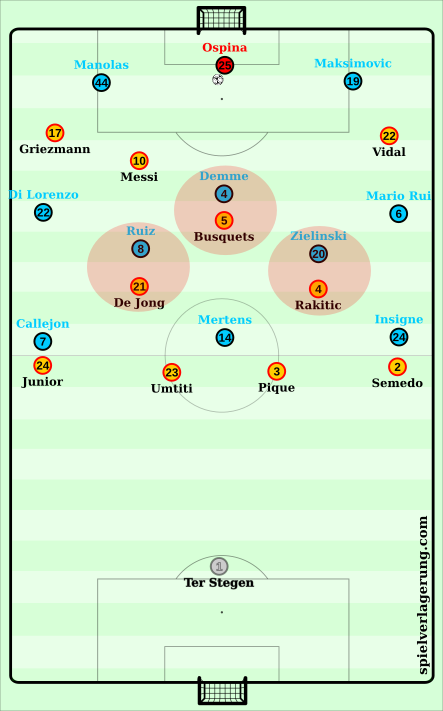
No.9, Messi, would move inside one CB, generally RCB Manolas.
No.6 Busquests would jump on the opposite no.6, Demme.
Both Barcelona no.8s would follow the Napoli 8s, Zielinski and Ruiz.
If the ball was played back to Ospina, Busquets would leave Demme and jump on the GK, trying to block the man he has left with his cover shadow.
If the player bouncing the ball back was an 8, de Jong or Rakitic would similarly jump.
Often Rakitic would also press the no.6, with Busquets remaining deeper on Zielinski.
4 vs 3 was left in the defensive line.
The image above shows how Barcelona generally pressed when Ospina had the ball in open play. Messi and Griezmann’s positioning invited Ospina to clip to the left-back, which would invite Vidal to trap Rui. This lent itself well to Vidal’s defensive attributes; quick, strong and tenacious. The furthest CM, the one left to press Demme, was mainly Busquets but would often be Rakitic. This role was interchangeable between the two, with the other occupying Zielinski.
Forcing long-kicks and winning aerial balls
Pressure on Ospina was used to force long-kicks and allow Barcelona to regain possession centrally. From here they could look to transition into the open spaces Napoli had left from being set for build-up, or they could restart their positional attack.
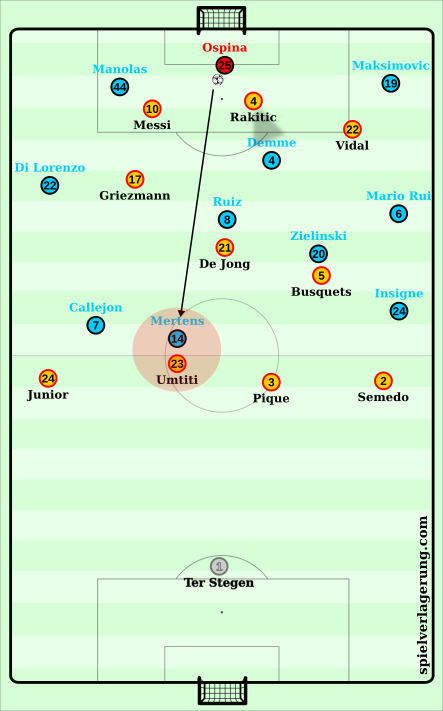
Although Rakitic leaves Demme to press and so the 6 is temporarily free, the angle of his approach to the goalkeeper blocks any short passess into the player. Messi’s positioning allows Griezmann to be closer to the right-back, so dissuading Ospina to play to this side. Although in this example Messi is passive, there was the odd moment in which Messi put pressure on the goalkeeper.
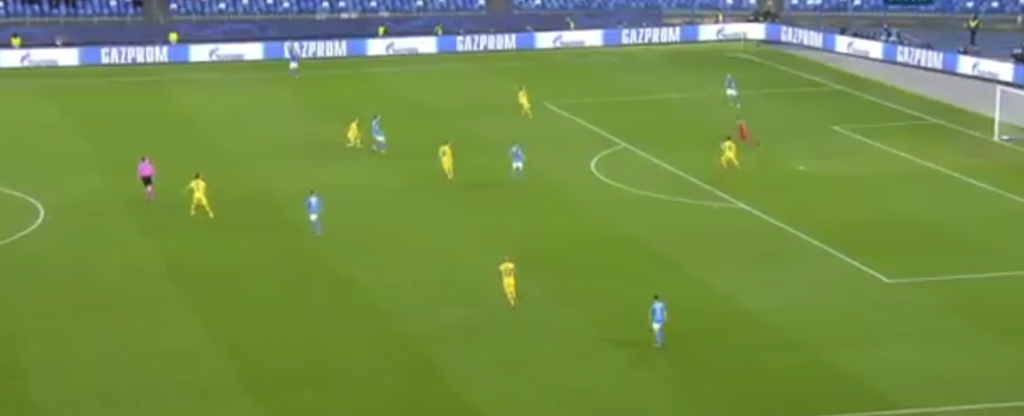
Because the 3 Napoli CMs have a higher starting position, here Messi puts pressure on Ospina. At many points in the match, Napoli are able to play out by exploiting Barcelona’s method of jumping a midfielder onto the GK, yet this example shows the potential benefits of Messi pressurising the GK, and leaving a 3vs3 centrally. Ospina could have built up short if the RCB drops deep, and quicky receives and plays to the RB on the outside of Griezmann. He instead opts to kick into an aerial duel which Pique wins, probably because he didn’t want to make a backwards pass to the CB.
Pressing trap on FBs
As we have touched on already, Vidal and Griezmann’s positioning half and half in between CB and FB offered Ospina a clipped pass option into the FB. With Messi generally positioning himself to the left of Ospina, this opened up a pass either direcly into Mario Rui, or into him via Maksimovic. As Vidal also positioned himself outside Maksimovic and inbetween Rui, this meant the only pass to Rui had to be in the air, allowing more time for him to be pressed. With Insigne remaining high, Semedo was pinned back from pressing Rui unless Pique moved quickly round with the rest of the defensive line.
However, this open pass was a trap! As the ball went into Rui, Vidal would aggressively press backwards, not necessarily with the sole intent of regaining possession, but of forcing throw-ins or fouls to allow Barcelona to have the opportunity to win the ball in the middle of the pitch again. Vidal would be joined by either Semedo, released from Insigne, or an extra central midfielder. Seeing as the three centre-midfielders were so man-orientated, this often depended on whether or not their man would go towards Rui. As we see later on, Napoli manipulated this to find spaces centrally.
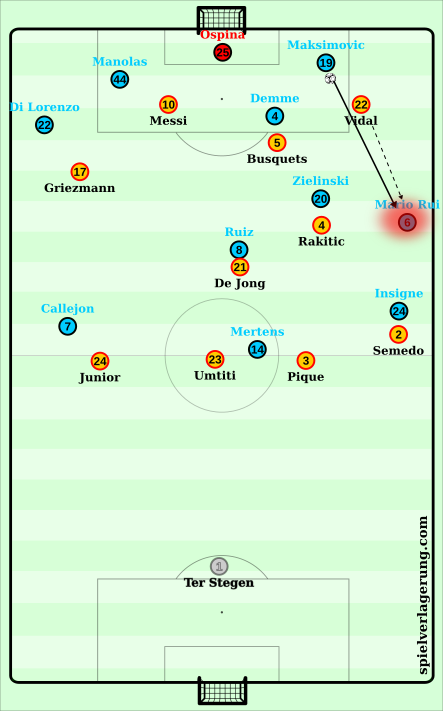
Block switch to opposite FB
Although this didn’t happen often, Vidal was also able to press the goalkeeper if the centre-midfielders remained man-marking centrally. When doing so, he left passes to the LCB and LB open. However, with the ball coming back to Ospina from the RCB, Vidal could press from the side of Ospina’s eye-line, meaning Ospina couldn’t turn out to his left to play to that side. He was left with having to try to curl the ball out to the left, but the arc of Vidal’s approach meant that this pass was not possible. The kick was directed too close to Semedo, and he was able to control it.
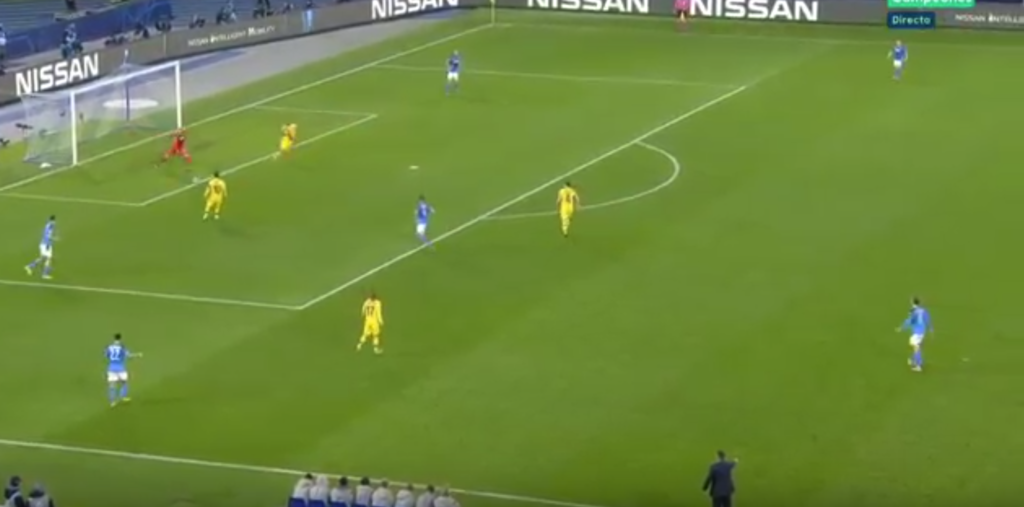
With better distribution, Ospina may have been able to play into the feet of Zielinski. If the midfielder was able to quickly drop down and make some space from him and Busquets, Ospina could have passed to his safe-side allowing him to either play first time out to Rui, or turn inside and maintain possession.
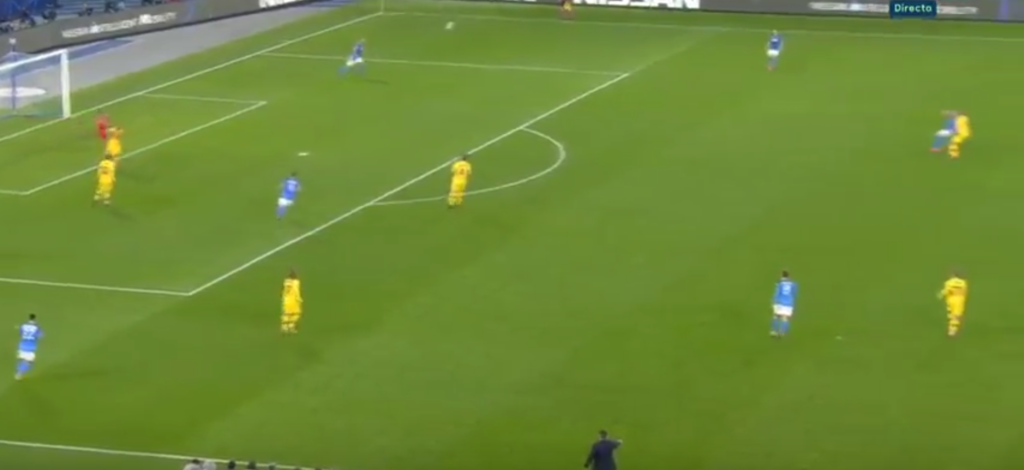
How did Napoli respond?
Barcelona’s high-pressing strategy was regularly manipulated by Napoli. With Messi playing a largely passive role in pressing, and the midfield 3 defending with a strong man-oriented approach, Napoli were able use these elements to open spaces to break Barcelona’s pressing. The main way in which they did so was from goal-kicks, when they would drop the no.6 and one no.8 down to the edge of the penalty box, or wide, to invite two Barcelona players to follow. They also exploited moments in which Barcelona’s CMs would jump onto the Napoli CBs or GK.
CMs dropping or moving wide
From goal-kicks, Napoli often dropped their CBs right down next to the 6 yard line, and also brought their FBs down to be in line with the edge of the 18. Then, Demme and one of the 8s, would drop down on either side of the D, or even inside the penalty box. In doing this, Napoli drew two Barcelona CMs right down towards their goal. The other 8 would move to the side where the ball was clipped to in order to draw the remaining Barca midfielder over to that side of the pitch. This created a large space in the centre, which Mertens would fill by dropping off, and Insigne would move into.
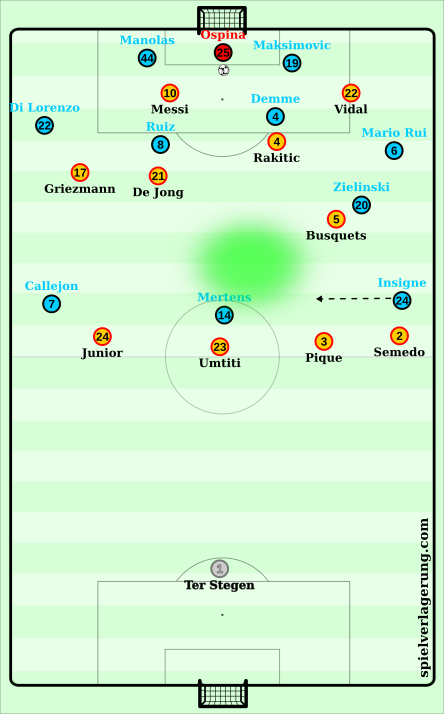
As Barcelona seemed to have quite specific instructions for their front 6 when high-pressing, Napoli were able to manipulate this.
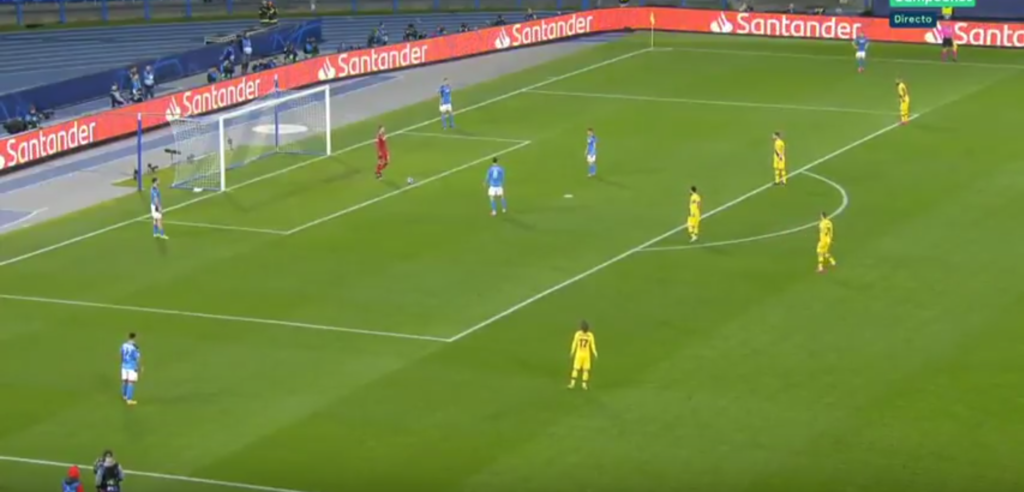
In the build-up to Napoli’s goal, a similar situation occurs from open play, but this time they bring the RB inside, in-line with Demme.
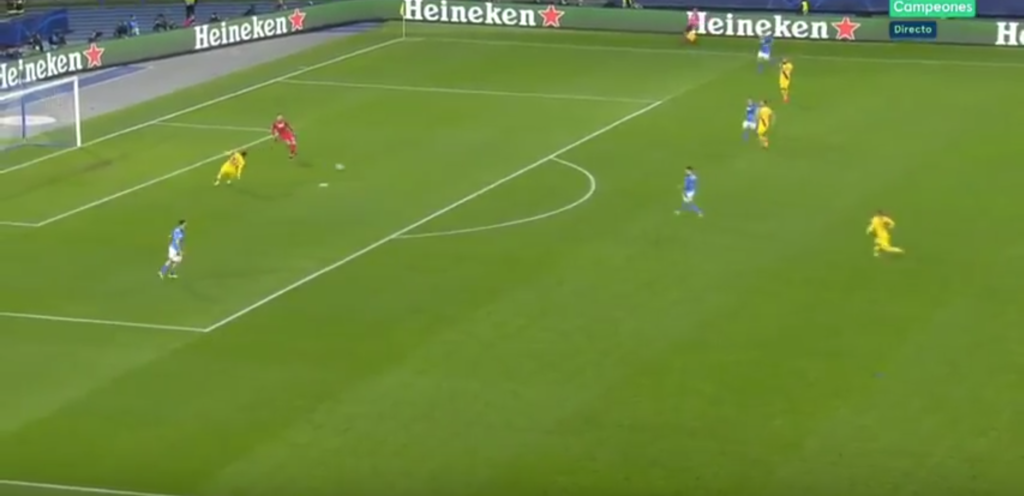
In this situation, the ball had been played quickly back to Ospina, and so was one of the rare situations in which Messi placed pressure on the goalkeeper as he was by far the nearest player. It was a bad decision, added to by the fact that he lost his footing and slipped. Behind him Di Lorenzo had rolled inside, whilst Busquets had jumped up onto Demme to his right.
This created a 4 (box)vs3 centrally with both 8s remaining high to pin back Rakitic and De Jong, allowing Di Lorenzo to turn and drive centrally.
Griezmann is unsure whether to press the RB centrally or stick to his instruction of pressing the RCB. This indecision allows the RB to turn.
Although Busquets recovers into position, he is not in line with the ball so allows an easy line-break pass, which leads indirectly to Napoli’s goal.
CMs wide + deep/exploiting CM-CB jump
As well as dropping down from goal-kicks, Napoli’s CMs also moved to the side. They did this when their CBs had possession higher. By doing this, they were once again able to move an opposition 8, but importantly bring Busquets away from the centre to open passing lanes into Mertens and Insigne.
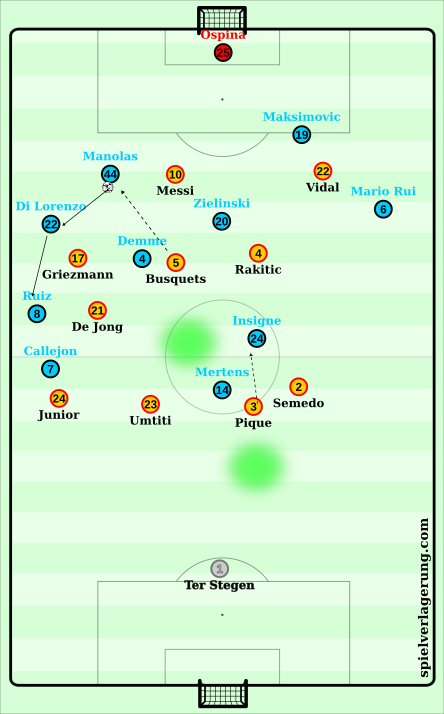
In this example, Demme and Ruiz initially both drop deep inside the right halfspace. This invites De Jong and Busquets to follow them. A bounce pass back to Manolas triggers Busquets jumping onto the CB to press. As Busquets jumps, Demme makes a run off him, and Ruiz moves out to the right side. Callejon is pinning Junior back, so De Jong follows his player out to the side. Zielinski also drops down, drawing Rakitic. The combination of these movements opens the space infront of Barcelona’s defensive line for Insigne to receive to feet. Pique also has to follow him, leaving a large space to play in-behind to Mertens or Callejon with a diagonal run.
Messi as a solution?
This diagram below shows how a simple adjustment to Messi’s positioning could have allowed Barcelona to retain defensive security in the centre of the pitch and press more affectively.
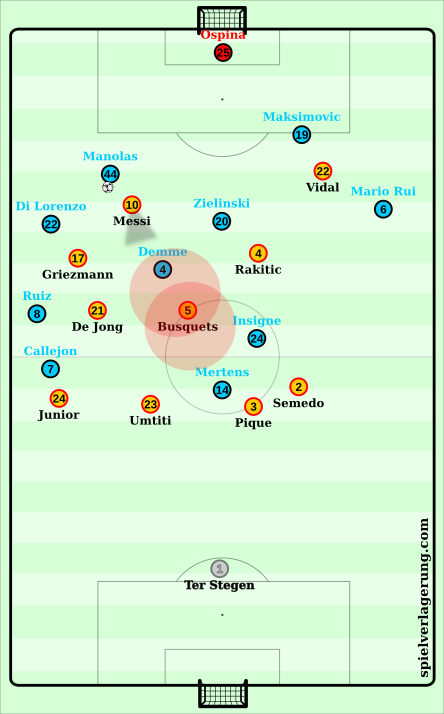
If Messi moves to pres Manolas from infront, and can block a pass to Demme with his body shape, Busquets is able to defend the space infront of Pique and Umtiti. The play progresses, and Ruiz is the player that makes the final pass into Insigne after dribbling inside. However, this is possible due to Busquets earlier man orientated focus on Demme and instruction to press the CB, leaving him out of position to engage Ruiz and block the pass into the pocket.
Wasteful Napoli
Napoli lacked some quality when they created positional or numerical superiority, and so didn’t make the most of these moments. In this clip, we can see a combination of ways they disrupted Barcelona’s high-pressing. Their short ball circulation encourages two midfielders to drop down to the edge of the box, the no.6 Demme + one no.8, allowing the other to stay high.
The bounce pass from RB to RCB triggers Busquets to jump onto the RCB, before Demme then moves out to the side to draw Rakitic away from the centre. Zielinski remains high, and Ospina’s clip to the LB invites Barcelona’s FB pressing trap, which Vidal and Semedo try to win.
Vidal and Semedo are both late to the ball. A better quality header from Rui and Barcelona would have had a 4vs2 counter-attack on the left. In the earlier scenario when Napoli built-up with two midfielders inside the box, Zielinski wastes a good opportunity to play first-time inside to Mertens after moving to the touchline. Here, a missed header from Rui wastes an excellent opportunity. Clever positioning and patient ball circulation from Napoli exploited Barcelona’s high-press, yet Napoli were unable to create an attack.
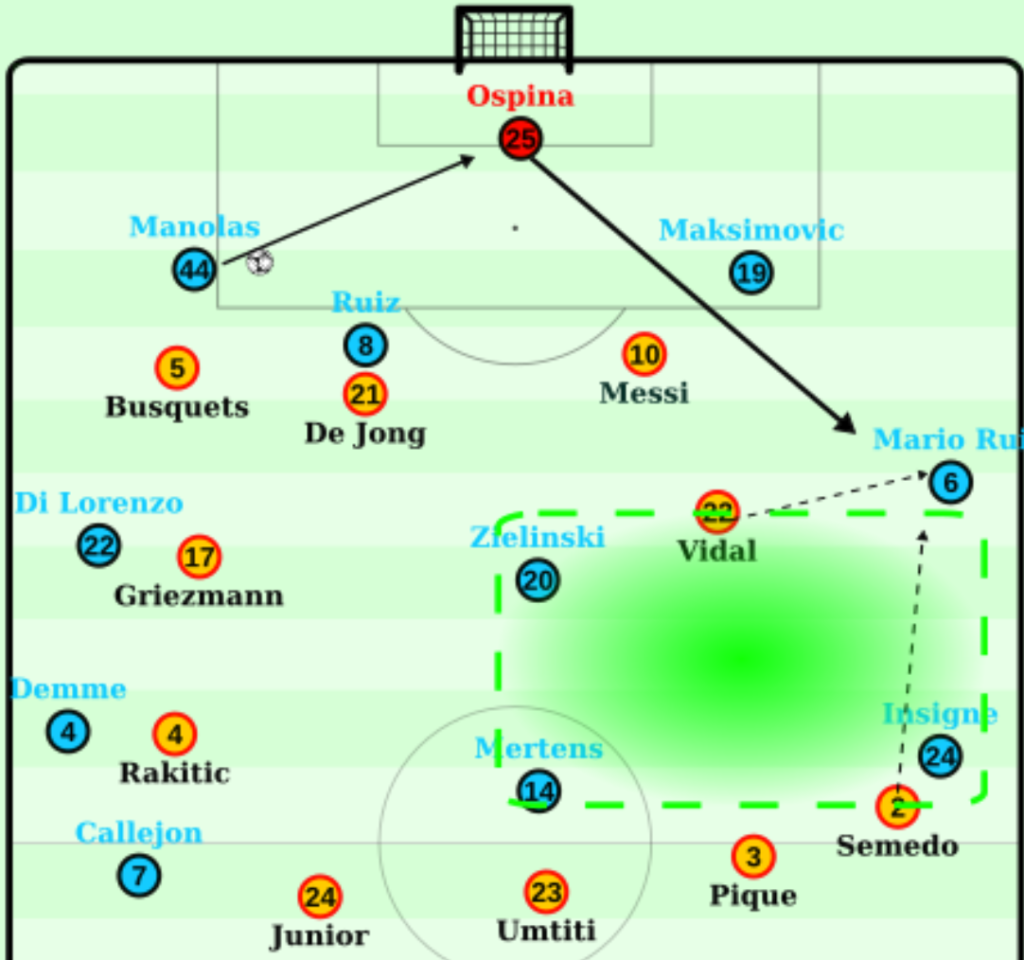
Counter-Pressing
A key element to Barcelona’s pressing was in defensive transition. Overall they counterpressed well, with good rest defense positions so that they could aggressively regain position when Napoli were disorganised having just regained possession. For the majority of the match Napoli were in a mid-block, with very compact spaces in the centre of the pitch. This meant that counterpressing regains offered the few moments in which Barcelona could find larger spaces to attack into, or switch play via the centre. Setien’s positional play game model organised Barcelona in similar positions throughout the match when in possession, with relatively short distances between players. This allowed for quick and aggressive counterpressing.
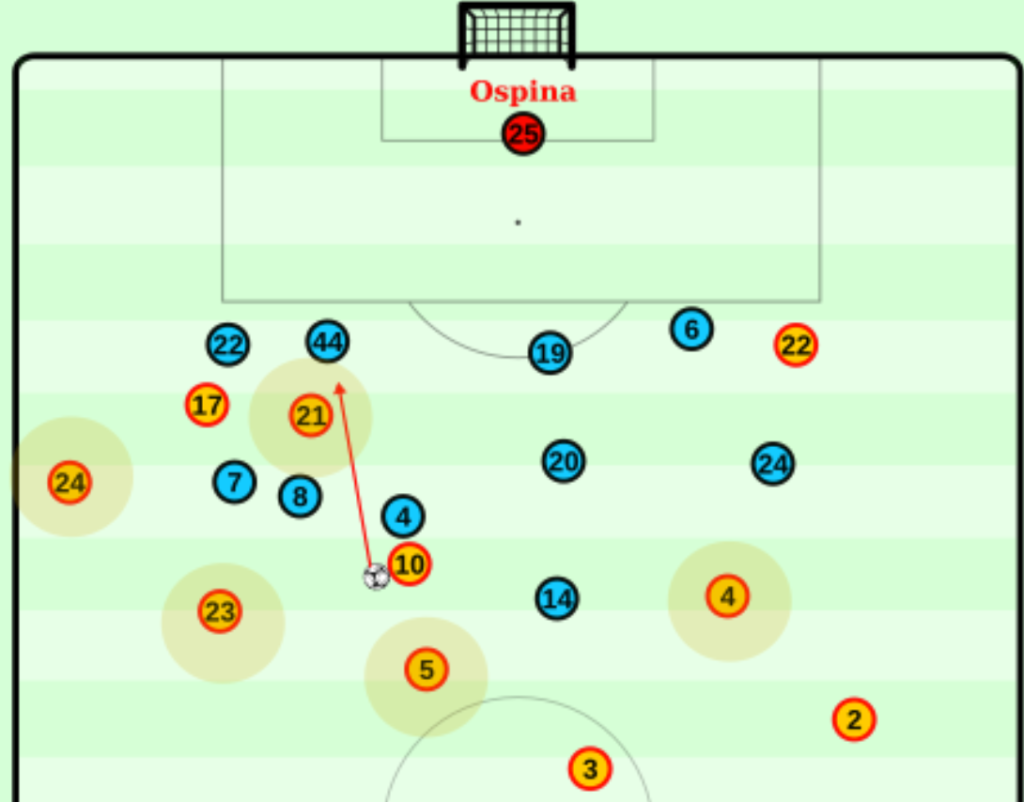
Here, de Jong and Griezmann’s positioning in between the lines means a loss of possession can be pressed forwards or backwards. Umtiti and Busquets are staggered, meaning they can quickly recirculate possession, as well as counter-press forward and be two separate lines of counter-pressure, dependent on where the ball lands. Rakitic moves inside quickly to regain possession centrally. His movement allows him to press Mertens or Zielinski from behind in the event the ball was given to them to escape.
Conclusion
Overall, Napoli were able to manipulate elements of Barcelona’s pressing, especially the man-orientated focus of their three centre-midfielders. The game ended 1-1, with Barcelona dominating possession as expected. Creating counter-attacks from build-up, by breaking Barcelona’s pressing, offered the best chance to create opportunities, but Napoli could not turn build-up into enough clear attacks.
Keine Kommentare vorhanden Alle anzeigen